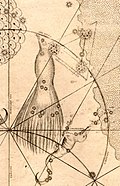Wikipedia:Today's featured article/February 17, 2019
Apus is a small constellation in the southern sky. It represents a bird-of-paradise, and its name (from Greek for "without feet") was chosen because the bird-of-paradise was once wrongly believed to lack feet. First depicted on a celestial globe by Petrus Plancius in 1598, it was charted on a star atlas by Johann Bayer in his 1603 Uranometria (pictured). The French explorer and astronomer Nicolas-Louis de Lacaille charted the brighter stars and gave them Bayer designations in 1756. The five brightest stars are all reddish in hue. Shading the others at apparent magnitude 3.8 is Alpha Apodis, an orange giant that has around 48 times the diameter and 928 times the luminosity of the Sun. Marginally fainter is Gamma Apodis, another ageing giant star. Delta Apodis is a double star, the two components of which are 103 arcseconds apart and visible with the naked eye. Two star systems have been found to have planets. (Full article...)

